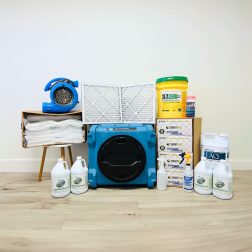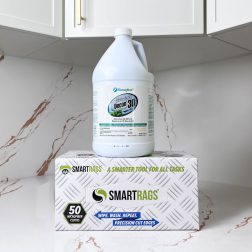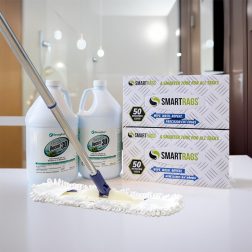No products in the cart.
Researchers have identified over 100,000 species of mold so far. With so many species, colonies come in all sorts of colors and textures. Hues can include yellow, green, grey, white, black, brown, red, or a combination of colors. No singular color indicates a more dangerous species, even though one of the most commonly discussed scary molds is "toxic black mold." While that specifically refers to Stachybotrys chartarum, many other species can also be black. As for texture, the growth could seem powdery, slimy, fluffy, or velvety. Again, no specific texture dictates whether or not the mold is dangerous. You may be wondering, though, what the top common species of mold are and if they are in your home.
It’s a phenomenal question to ask! Understanding what exactly is in your home sets the foundation for successfully stopping unwanted exposure. It also helps to understand where the exposure is occurring. Is it in your home or somewhere else, like work?
With that in mind, here are the 12 top common species of mold found in homes.
12 Top Common Species of Mold
All of the species of mold present in the world fall under three main categories.
These categories are:
- Allergenic: Molds that cause allergies and allergic reactions such as asthma attacks
- Pathogenic: Molds that cause health problems in those suffering from acute illnesses
- Toxigenic: Molds that produce toxic substances and can lead to dangerous or even deadly health conditions—sometimes referred to as toxic mold
Our clients have dealt with these top common species of mold in their indoor environments.

1. Acremonium
Acremonium mold is a type of toxigenic mold that undergoes changes in its appearance over time. Initially, it forms as a small, damp mold that eventually turns into a fine powdery substance. It often appears in shades of pink, gray, orange, or white and typically thrives in areas with moisture such as humidifiers, cooling coils, drain pans, and window sealants.
Exposure to Acremonium can be hazardous and may lead to illnesses affecting the bone marrow, immune system, and other organs. Since it is also a carcinogen, Acremonium can hinder brain function. Additionally, it sometimes coexists with other molds like Stachybotrys, leading to hazardous contamination and severe exposure in homes.
2. Alternaria
Alternaria is one of the most common allergenic molds globally. It features a velvety texture with dark green or brown hues. This mold often grows in damp areas such as showers, bathtubs, and beneath leaky sinks. Alternaria may also manifest due to water damage in buildings. Known to trigger asthma-like symptoms in the upper respiratory tract, nose, and mouth, Alternaria requires prompt remediation to prevent it from overtaking a home.
3. Aspergillus
Another widely found mold in households is Aspergillus. It forms long, flask-shaped spores that can create dense layers or "walls" of growth. With over 185 species in the Aspergillus family, this mold can take on various colors.
Although Aspergillus is allergenic, its toxicity may vary depending on the species and environmental conditions. Some Aspergillus species produce aflatoxins, which are known for their carcinogenic properties. Exposure may result in asthma attacks, lung infections, and respiratory inflammation.
4. Aureobasidium
Aureobasidium is an allergenic mold that often grows behind wallpaper or on painted or wooden surfaces. Typically starting off as pink, brown, or black, it darkens over time. This mold can cause infections of the eyes, skin, and nails. Due to its ability to cause skin rashes, it should never be handled with bare skin.
5. Chaetomium
Chaetomium is a mold often found in water-damaged homes and buildings, particularly in areas with leaking roofs, basements, burst pipes, or sinks. Since it thrives in chronically moist conditions, addressing the root cause of water damage is crucial to prevent its recurrence. It has a cotton-like texture and may change colors from white to gray, brown, and eventually black. Its musty odor can help identify its presence.
Exposure to Chaetomium can lead to skin and nail infections, as well as mycotoxin production in individuals with compromised immune systems.
6. Cladosporium
Cladosporium is a unique allergenic mold that can grow in both warm and cold environments. Commonly found in fabrics, upholstery, carpets, under floorboards, and inside cupboards, It exhibits a suede-like texture and comes in olive-green or brown hues.
Exposure to this mold may cause allergic reactions, including skin rashes, asthma, lung infections, and sinusitis. Although not considered toxic, Cladosporium should not be touched directly as it can cause skin and lung irritation.

7. Fusarium
Fusarium is a mold that can thrive even in cold temperatures. It is both allergenic and toxigenic and grows in homes with water damage. Often found in carpeting, wallpaper, fabrics, and natural compost, Fusarium can be pink, white, or reddish in color.
Exposure to Fusarium may result in skin infections, sore throat, runny nose, sneezing, itchy eyes, and dermatitis. Prolonged exposure can lead to severe conditions such as bone infections or brain abscesses. It produces toxins harmful to the nervous system and may cause internal bleeding.
This mold spreads quickly, so if you find it in one area, check the rest of your home for its presence.
8. Mucor
Mucor is an allergenic mold that forms thick patches of white or grayish growth. It typically grows near air conditioning units, HVAC systems, and ductwork due to moisture from condensation.
Mucor can cause respiratory issues and exacerbate asthma symptoms. It may also lead to flu-like symptoms, including fever and general discomfort. In severe cases, prolonged exposure to Mucor may cause mucormycosis, a fungal infection that can damage the sinuses, lungs, and brain. It may also spread to the eyes, nose, and blood, posing significant health risks.
Consult a professional remediation expert for effective mold removal, especially when dealing with potentially hazardous species like Mucor.
9. Penicillium
Penicillium is an allergenic mold easily identified by its distinctive blue or green surface with a velvety texture. It often appears in water-damaged homes and buildings, thriving in materials such as carpets, wallpaper, air ducts, and even mattresses. Like other mold species, it can quickly spread throughout the home.
Though Penicillium plays a crucial role in producing antibiotics and aiding in food processing, its presence indoors can lead to respiratory issues. The spores can become airborne and be inhaled by residents, including pets and children. This can result in pulmonary inflammation, asthma, and even chronic sinusitis. Those with immune disorders should avoid exposure to Penicillium, as it can exacerbate symptoms and lead to further health problems.
To prevent Penicillium growth and spread, it’s essential to address any household leaks or water damage promptly.
10. Stachybotrys
Stachybotrys, often known as “black mold,” is a toxigenic mold with a dark greenish or black color and a slimy texture. It thrives in damp, humid areas that remain consistently moist for weeks. Stachybotrys grows on cellulose materials such as wood, cardboard, paper, and hay.
This mold produces mycotoxins that can lead to serious health problems upon exposure.
Symptoms may include difficulty breathing, sinusitis, fatigue, and depression. Common issues include dull aches and pains in the mucous membranes and burning sensations in the airways. Exposure may also lead to tightening of the chest, persistent cough, nosebleeds, fever, and severe headaches. It has been linked to neurological issues in children and pulmonary bleeding in infants.
If you find black mold in a home with children, remove them from the environment to avoid exposure. Contact a mold remediation professional to ensure the safety of your home.
11. Trichoderma
Trichoderma is an allergenic mold with five subspecies characterized by a wooly texture that changes over time. Typically, it starts as white with green patches and grows quickly into more compact clusters. It commonly appears on wet surfaces in the home, such as wallpaper, carpet, and damp fabrics, and can also be found in air conditioning filters and HVAC ducts.
Most Trichoderma molds are nonpathogenic, but some can cause pulmonary and hepatic (liver) infections. When producing mycotoxins, Trichoderma behaves similarly to Stachybotrys. This species of mold can also cause extensive damage to building materials due to an enzyme that deteriorates wood, paper products, and textiles, resulting in rot and crumbling. Professional treatment is essential to halt the destruction and mitigate health risks.
12. Ulocladium
Ulocladium is a black mold that thrives in areas with significant water damage, such as kitchens, bathrooms, basements, and condensation-prone windows. It often grows alongside Stachybotrys, Fusarium, and Chaetomium, serving as an indicator of water damage.
This mold has two subspecies, which can cause serious health issues. General asthma-like symptoms and breathing difficulties are common effects of exposure, while some individuals report severe reactions like hay fever and skin infections.
Why Is Knowing the Top Common Species of Mold Important?

The above information is important when examining the overall air quality because it’s used to collaborate with the medical laboratory results to determine which molds or toxins are present and what effect they can have. Each project will have different species of contaminants and different quantities of infiltration into the home's living systems. The more we know, the better informed we’ll be on how to proceed with remediation.
Getting rid of all the contamination in the house is not always financially feasible. That’s okay! When that’s the case, knowing which contaminants are present and in which quantities will help prioritize which areas to focus on improving so that the work will provide the most positive change in the home's overall air quality. Understanding the species and quantities will help you better create a cost analysis to get the most bang for your buck on improving your indoor space and reducing exposure. That’s the ultimate goal.
Let’s say you have an attic, an HVAC system, and a bedroom with sources of contamination. The HVAC system has the highest concentration of contamination. The attic, where the HVAC system is located, has the second highest concentration. Meanwhile, the bedroom is the third highest concentration. When you are limited on funds, the professionals you’re working with will look at your home as a whole system and make recommendations to improve the indoor environment by decreasing concentrations of contaminants as much as possible. In this example, they should recommend remediation of the HVAC system and the attic to ensure a healthier environment for the system to function. When there is room in the budget, you can prioritize the bedroom. This way, you can address the issues causing the most damage to air quality from the get-go, lightening the overall toxic load until you can completely remediate all sources.
As a final consideration, always prioritize toxigenic mold species like Stachybotrys or Chaetomium because they can be detrimental to health. Also, prioritize specific mold species that produce mycotoxins, especially ones that might be problematic for you. Your medical testing results will provide insights into which are affecting you the most.
How to Test for the Top Common Species of Mold in Your Home
Step One: The Dust Test
Gravity brings particles like mold spores, mycotoxins, and endotoxins down to horizontal surfaces like floors, doorframes, and furniture. Where dust collects, so do these indoor contaminants. Testing this dust with The Dust Test will help determine what is in your home. It can indicate if a problem needs to be addressed or give you peace of mind that you’re hanging out in a safe environment.
The data collected will indicate what mold you’re being exposed to, including the top common species of mold, before your inspector comes so that you can ensure they will find where it’s coming from. It can also indicate if mycotoxins and bacteria are present and what species.
Why is this important? Traditionally, inspectors conduct dust testing while they’re inside the home. By the time the results return, though, they’re long gone and working for the next client. This can confuse you and make you wonder if they really "got it all" while collecting data. With The Dust Test, you’ll identify the mold, bacteria, and biotoxins in the home that the inspector needs to find sources of.
Step Two: Hire an Inspector
A qualified mold inspector sets the foundation for properly handling a contamination situation. All the data they collect will help create a comprehensive protocol for the remediation team to handle the toxic situation appropriately. A proper inspection should take a few hours at a minimum and use various methodologies. A simple air test in the middle of the room does not qualify as a proper inspection.
All of this information is needed to understand what exists in the home to create the right protocol for the unique situation. If other contaminants, such as mycotoxins and bacteria, are present, the remediation protocol must address this. Should spores make their way into the HVAC, this must be remedied. Otherwise, those particles will blow all over the home and could turn into a new mold colony.
How to Remediate The Top Common Species of Mold
The short answer to how to remediate the top common species of mold is simple. All mold should be remediated the exact same way– quickly and correctly. As mentioned above, understanding the species is important for making a plan of action regarding the timeline should there be budgetary constraints.
With that in mind, all of the information collected by the inspector will create a detailed picture that will help a qualified remediation team eliminate the problem and help create a safe indoor environment for you and your family. This company should first and foremost prioritize your health and understand the importance of a healthy indoor environment. Their protocol should also have these three main pillars to ensure success.
These three pillars are:
- Remediate the sources properly
- Identify and address the problems that led to those sources in the first place
- Eliminate all contamination that’s present
When the team finishes, they should verify their work with post-testing to ensure that the home is back to normal ecological levels and healthy for you to return.
Check out our free resources database for more information on what to expect during remediation.
Remediating the Top Common Species of Mold Yourself
If you want to attempt a remediation project, proceed cautiously and only work on areas under 10 square feet. Contacting an expert beforehand can give you a full breakdown of how to address the issue properly.
Things to keep in mind:
- Use correct engineering controls and put PPE in place
- The source that led to the growth needs to be resolved
- All porous materials, like drywall, need to be removed and replaced
- All surfaces need to be decontaminated using the proper remediation protocols based on the specific surface type
- The surrounding space should be deeply cleaned to remove any particles released by the active growth
If you aren’t confident that you can tick off each box, the professional route is the way to ensure all the contamination is removed. When it comes to your health and happiness, it’s best to do this process correctly the first time to avoid prolonged exposure and wasted time and money.
Anything larger than 10 square feet should automatically be handled by professionals.
-

HomeCleanse DIY
$5,995.00 – $9,995.00All the equipment and materials we use to remediate your home, plus consultation and support with us on how to do it yourself safely.
-
Select options -

Mold & Bacteria Contents Cleaning
$99.00 – $349.00Remove harmful pollutants that accumulate in the dust of your home. (Options available for renters and homeowners with apartments and homes up to 4,800 sq feet)
-
Select options -

HomeCleanse Cleaning
$299.00 – $549.00Take your cleaning to the next level buying all the tools we use to keep our clients homes clean. (Perfect for renters and homeowners for homes up to 4,800 sq feet)
-
Select options
Building Awareness
This information isn't meant to make you fearful. Knowledge is power! Being aware of things like the top common species of mold will allow you to make decisions that support your wellness and give you peace of mind that you’re on the track to success.
Health begins at home.

